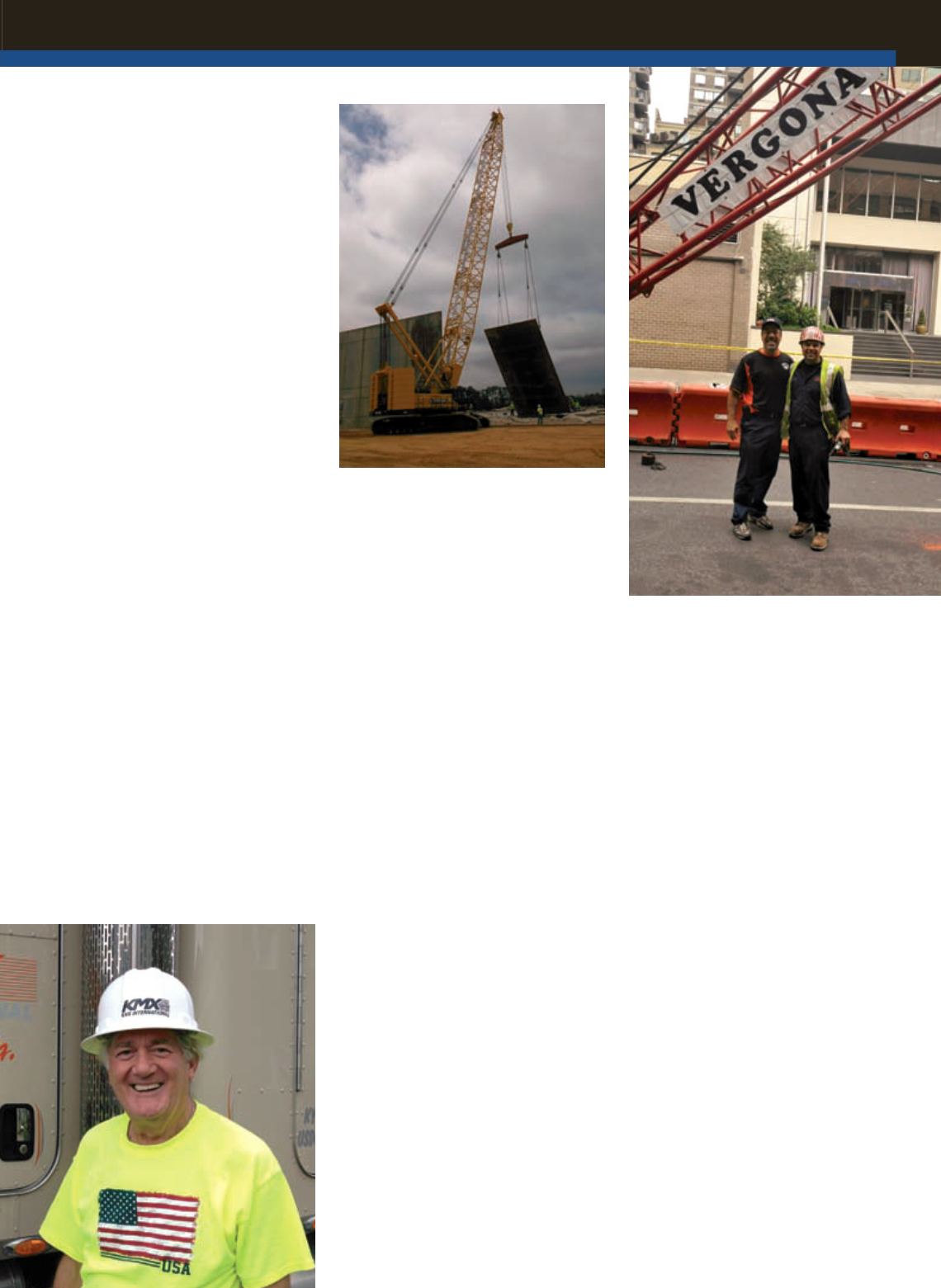
Operating in a lukewarm economy, Jones
says his company’s economic situation has
leaped forward in dramatic ways.
“We’re making money again,” he says.
“And that’s great. We expect to stay
profitable for some time.”
A fourth-generation company, Vergona
Crane Services also deals with positive
change. The Englewood, New Jersey
company has kept busy with projects
primarily in Manhattan and northern
New Jersey. Now the business seems to be
growing across from Manhattan into the
Jersey City and Hoboken areas.
“Lots of high-rises are going up in and
around those cities,” says Joe Vergona,
who co-owns the company with his
brother Ron.
The Vergona family served that area in
the 1940s and 1950s, when chemical and
manufacturing sites filled the landscape.
Those plants are long gone. Now it’s
trending toward business and residential
erections.
“That’s good for us,” Joe Vergona says.
“Our Manitowoc 222s, 888s and 999s have
been very busy. We use them in what we
call our tower configuration. There’s also
more demand for our hydraulic cranes.
“We’re happy to see all this development
across from Manhattan’s skyline. As the
building market picks up, so does our
business.”
Boston’s ‘seaport’ growing
At Boston-based Shaughnessy and
Ahern, Jack Shaughnessy, the 87-year-old
chairman, sees continued prosperity for
his city and his organization.
“High-tech companies, hospitals and
universities have always provided lots of
work for our company,” says Shaughnessy.
“They still do.”
His company’s hydraulic cranes lift up to
360 tons. Its low-bed trailers haul loads as
heavy as 450 tons.
“Even though there are areas of Boston
and Cambridge that are running out of
space, there’s still lots of work for our
company,” he adds.
The Seaport District has given new
impetus to his company’s project schedule.
It’s in an area of south Boston that has
slowly emerged from neglect.
“Twenty years ago, it was a wasteland,”
Shaughnessy recalls. “Lots of old buildings
and railroad tracks. That’s all changed
now. Office buildings are going up. High-
rises, too. It seems as though more people
don’t want to spend an hour commuting
to Boston in the morning, then another
hour driving home after work. So they
decide to live in one of those new high-
rises.”
Three of Shaughnessy’s four sons run his
company’s day-to-day operations.
“I’m only here from 10 to 4:30,” the
eldest Shaughnessy says. “I can’t work long
days any more. We’re a busy company, so I
still look forward to several more years of
doing this.”
■
“Most steel mills are moving out of the
U.S., but this will be a new one in our
country,” Vitez says. “We’re working for
five or six contractors. Before undertaking
this project, we needed to reach an
agreement with the contractors that we
had to maintain service to our customer
base.”
Vitez says the project requires as many as
15 truckload deliveries every day.
“Even with this extra work,” he says,
“we’ve been able to maintain our just-in-
time deliveries.”
As KMX expanded to meet the new
project‘s demands, Mel Jones improved
his company, Pioneer Heavy Haul, by
shrinking it. It’s down by about two-thirds
from its former size.
“I’ve been in this business 40 years and
always made money,” Jones says. “Until a
few years ago.”
Headquartered in Canada, Pioneer hauls
throughout upstate New York from its
Buffalo office.
“Until a few years ago, we had 150
pieces of equipment and 55 people,” Jones
reports. “We were accepting business that
didn’t pay because we thought we had to
do that. Like they say, we did work just
to keep the big wheel turning. We finally
decided the only thing we could do was
realign. As much as we didn’t want to do
it, we had no choice. We couldn’t have
kept going the way we were going and
expect to survive. We also developed a
new strategy. We would no longer take on
a project unless it was profitable.”
Jones observes that upstate New York has
not had a major economic uptick.
“The oil business is doing well here, and
also electric power,” he says. “That’s about
it. Manufacturing is still down. A lot of
what used to be manufactured is now
imported.”
Vergona has experienced a surge of new
business in northern New Jersey, according
to co-owners and brothers Ron and Joe
Vergona.
United Crane
& Rigging’s
Kobelco
crawler
performs tilt
wall work.
EASTERN US
REGIONAL REPORT
JULY 2013
ACT
27


